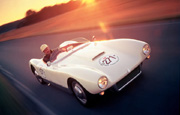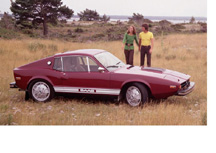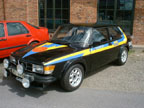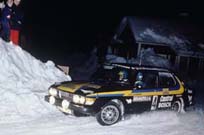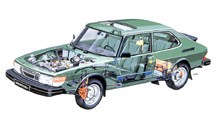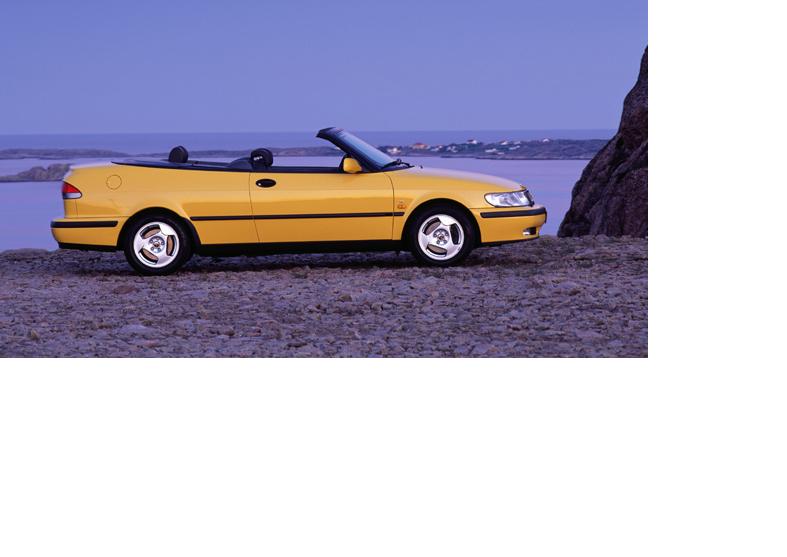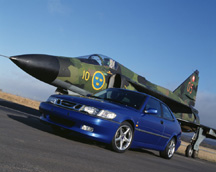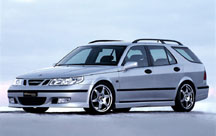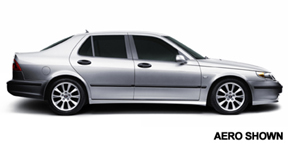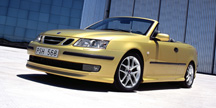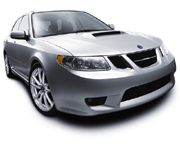Source: Saturn CorporationSaturn Corporation was formed as a wholly-owned subsidiary of General Motors in January 1985. The Saturn concept began in 1982 as a response to increasing import competition and a traditional, adversarial relationship between union and management. The two would ultimately form a partnership to study and implement an innovative way to develop and market U.S. manufactured small cars. Together, this partnership created a distinct and clear mission, supported by a philosophy and set of shared values. Saturn’s mission, philosophy and values are all directed toward recapturing new customers and achieving world-class levels of quality and customer enthusiasm.
The "Different Kind of Company," currently produces a small sedan, wagon and coupe at its 4.6-million-square-foot manufacturing and assembly site in Spring Hill, Tenn. As a "green field" site, the auto plant balances people and technology with an advanced focus on ergonomics and environmental stewardship.
In 1999, Saturn added a second vehicle line, the midsize L-Series sedan and wagon, which are built in Wilmington, Del. A third vehicle, the VUE sport utility vehicle, will begin production in Spring Hill in 2001.
During the last 15 years, Saturn has reshaped the way automakers build and sell cars. How the Saturn vision became reality is a unique story, and these are the significant events in Saturn’s continuing development.
1982 JUNE - Alex C. Mair, then vice president of what is now GM's Advanced Engineering Staff, summons engineers Joe Joseph and Tom Ankeny to his office. They discuss a new, innovative, "small car project."
JULY - "Saturn" is selected code name for the project. Phil Garcia, chief designer - Advanced Studio -- GM Design Studio is credited with the selection of the "Saturn" name. (Saturn refers to the Saturn rocket that carried Americans to the moon during the space race with the USSR. The Saturn small car project's goal is to design an American vehicle that can beat the Japanese in the small-car race.)
1983 OCTOBER - Donald F. Ephlin, vice president and director of the United Auto Workers' General Motors Department, and Alfred A. Warren, Jr., vice president of GM's Industrial Relations staff, agree to pursue the concept of a GM-UAW Study Center to explore new approaches to building small cars in the United States.
NOVEMBER - Saturn project announced publicly by General Motors Chairman Roger B. Smith and General Motors President F. James McDonald.
DECEMBER - Ephlin and Warren hold joint press conference at Solidarity House (UAW Headquarters) in Detroit and announce the creation of a new GM-UAW Study Center to review new relationships and approaches to the operation of the Saturn project.
1984 FEBRUARY - The historic "Group of 99" is appointed. It comprised of 99 UAW members, GM managers and staff personnel from 55 plants in 17 GM divisions, and 14 of 16 UAW regions. The 99 immediately separated into research teams to study intricate aspects of what Saturn could be.
JULY - President Reagan visits the Saturn project at the General Motors Technical Center in Warren, Mich., and congratulates GM on an historic effort to help keep the United States prominent in the auto industry.
SEPTEMBER - First Saturn demonstration vehicle completed for evaluation.
1985 JANUARY - GM announces addition of new automotive operating unit -- Saturn Corporation, a wholly-owned subsidiary company -- to its passenger car divisions. Joseph J. Sanchez, Saturn president, dies at Sparrow Hospital in Lansing, Mich.
FEBRUARY - William E. Hoglund appointed new Saturn president.
JULY - Historic new labor agreement for Saturn reached between GM and the UAW establishing the partnership. Selection of Spring Hill, Tenn., as site for Saturn's manufacturing facility finalized.
1986 JANUARY - Saturn's first concept car built in 100 work days by its Vehicle Concept Development (VCD) Team. A record for General Motors.
FEBRUARY - Richard G. "Skip" LeFauve named president of Saturn Corporation.
APRIL - Official dedication of the site for Saturn's manufacturing and assembly complex near Spring Hill, Tenn.
OCTOBER - First 4-door 3/8 scale plastic model completed.
NOVEMBER - First 4-door mule car completed by Chassis team.
1987 APRIL - Four-door clay released from Design Staff.
JUNE - The first of more than 275,000 cubic yards of concrete is poured at Saturn's new manufacturing and assembly complex.
JULY - First Saturn-intent vehicle built with all thermoplastic panels; excluding steel roof and hood.
OCTOBER - First SC coupe mule car completed by the Chassis Business Team.
DECEMBER - Saturn unveils its new corporate signature -- a stylized version of the ringed planet (bright red field with a neutral gray Saturn script).
1988 JUNE - First 4-door demonstration car completed.
SEPTEMBER - First SC coupe demonstration car completed.
1989 FEBRUARY - Saturn's first print advertisement appears in Automotive News announcing its first 26 dealer partners. The ad is the first public work from Hal Riney & Partners, Saturn's advertising agency.
MARCH - First 4-door pre-production vehicle completed.
NOVEMBER - First Saturn engine produced by powertrain team at Spring Hill complex. First SC coupe pre-production vehicle completed.
1990 JANUARY - SC coupe demonstration vehicle completed 100,000 mile test program at Lotus Millbrook Proving Grounds.
JULY - At exactly 10:57 a.m. CDT, General Motors Chairman Roger B. Smith and UAW President Owen Bieber drove a red metallic four door sedan off the final assembly line in Spring Hill. Smith and Bieber were joined by GM Executive Vice President Lloyd E. Reuss and UAW Region 8 Director George H. Smith.
OCTOBER - Saturn officially launched its new family of small cars by sending its first truckload of vehicles from Tennessee to California. Saturn President Richard G. "Skip" LeFauve announces that cars will go on sale in key markets in California, the south and southeastern United States on October 25, 1990.
1991 MAY - Saturn voluntarily replaces 1,836 cars due to improperly formulated coolant (antifreeze) supplied by Texaco Refining and Marketing, Inc. Due to Saturn's commitment to providing a superior level of customer satisfaction, the company chose to replace rather than repair these vehicles.
AUGUST - Start of production for 1992 model Saturns.
OCTOBER - Start of sales in Canada through approximately 70 Saturn-Saab-Isuzu retail facilities.
1992 JANUARY - Saturn unveils a sporty new wagon which will highlight the automaker's 1993 fall lineup at the Los Angeles Auto Show.
MARCH - Saturn sells its 100,000th car.
APRIL - Saturn received MotorWeek/PBS television’s "1992 Driver’s Choice Award for Best Small Car" for the second year in a row. First shipment of Saturn vehicles leaves California port bound for Taiwan.
AUGUST - Saturn sells it’s 200,000 car. Start of production for 1993 model Saturns.
1993 FEBRUARY - Saturn sells its 300,000th car.
MAY - Saturn produced its 400,000th car. Saturn has sold over 370,000 vehicles between the domestic and export markets.
SEPTEMBER - Saturn produces its 500,000th car.
1994 MAY - Saturn produces its 700,000th car.
JUNE - 44,000 Saturn owners and their families attend the Saturn Homecoming in Spring Hill. Throughout this weekend and summer, Saturn retailers also held regional Homecoming events attracting over 130,000 customers. In all, 1 of every 6 Saturn customers participated in the Homecoming.
JULY - Saturn’s 300th retail facility opens.
OCTOBER - Saturn produces its 800,000th car.
1995 FEBRUARY - Saturn produces its 900,000th car.
JUNE - Saturn’s One-Millionth vehicle (a Dark Green 1995 SC2 coupe) is produced at the Spring Hill, Tenn., manufacturing and assembly complex.
1996 NOVEMBER - Saturn’s right-hand-drive SL2 sedan, SW2 wagon and SC2 coupe models make their public debut at the Osaka Import Automobile Show in Osaka, Japan.
DECEMBER - The first GM EV1 electric vehicles are delivered to customers through Saturn’s 24 retailers serving Southern California and Arizona.
1997 JANUARY - A blue SC2 becomes the 1.5-millionth Saturn vehicle produced at its Spring Hill, Tenn., facility.
MARCH - Saturn announces that it will begin sales of right-hand-drive models (SL2, SW2 and SC2) in Japan on April 5, 1997. Pricing will be comparable with competitors and, like its U.S. philosophy, will use a no-haggle/no-hassle sales strategy. A Black-Gold SC2 Coupe is the first Saturn right-hand-drive vehicle to be unloaded at the Port of Toyohashi, Japan. A total of 220 Saturn sedans, wagons and coupes were carried aboard the cargo ship Turandot.
APRIL - Saturn begins its first day of sales in Japan through eight retailers.
1998 OCTOBER - Saturn unveils its 1999 3-Door Coupes at the New England International Auto Show in Boston. The driver’s side rear access door will become a standard feature on all SC1 and SC2 models beginning in early November 1998.
NOVEMBER - Production of the "world’s first" 3-Door Coupe rolls off the Spring Hill assembly line.
DECEMBER - Saturn announces two new mid-size Saturns will join its product lineup in 1999 when the all-new L-Series sedan and wagon debut at Saturn retailers in the U.S. and Canada. The LS and LW will compete with mid-size imports such as Toyota Camry and Honda Accord.
1999 JANUARY - Saturn’s Two-Millionth vehicle (a Red 1999 three-door SC2 coupe) is produced at the Spring Hill, Tenn., manufacturing and assembly complex.
MARCH - The Saturn L-Series sedan and wagon are unveiled to the media at the 1999 New York auto show.
AUGUST - The re-designed Saturn S-series coupe and sedan go on sale at Saturn retailers across North America.
2000 APRIL - GM $1.5 billion capital investment in Saturn announced. Saturn’s plan includes the potential for four new products over the next four years. Saturn announces a series of strategic moves to aggressively grow the brand. GM approved Saturn’s sport utility vehicle (SUV), which will go into production at Saturn’s Spring Hill, Tenn. Facility in late 2001. GM will make a $1 billion capital investment in Saturn’s Spring Hill manufacturing facility through 2002. Saturn’s SUV and next generation small cars will include GM’s new global four-cylinder engine. Spring Hill was awarded GM’s third production module for this engine, including strategic machining and assembly. One of Saturn’s undisclosed future models will include a high-tech V6 engine from GM’s recent agreement with Honda.
OCTOBER - Saturn unveils the 2002 Saturn VUE sports utility vehicle at the South Florida International Auto Show in Miami.
2001 OCTOBER - Saturn announces ION as the name for its new small car line that will replace the current S-Series. IOPN is the first car of the Delta platform and features a coupe and sedan.
NOVEMBER - Saturn’s Spring Hill Manufacturing Complex begins saleable production of the Saturn VUE.
2002 AUGUST - Saturn unveils SKY concept car in Pebble Beach, California. The SKY is a compact convertible, fresh, versatile open-air roadster. SKY is a four-season vehicle spacious enough to move people and cargo comfortably through traffic without abandoning the coziness of a classic roadster.
MARCH - Saturn unveils the ION sedan and coupe at the New York Auto Show. The ION is the first of GM’s Delta cars and replaces the Saturn S-Series.
Compact Cars
- The S-Series made its debut in 1991 with a sedan (SL) and a coupe (SC). A wagon option (SW) was introduced in 1992. The S-Series racked up several car awards during its production run, including overall value recognitions from automobile publication IntelliChoice in 1993, 1997 and 2000. The Ion, which replaced the S-Series in 2003, was noticeably larger than its predecessor (indeed, the longest compact car sold in the United States). However, the Ion was never as successful, and it ceased production in 2007. The Astra, essentially a foreign-built vehicle stamped with the Saturn nameplate, replaced it in 2008.
Midsize Cars
- The L-Series made its debut in May 1999 as a 2000 model, designated as either an LS (sedan) or LW (wagon), with four-cylinder and V6 engine options. Like its compact-car counterpart, the Ion, the L-Series experienced sluggish sales. Saturn pulled the plug on the line in 2005, replacing it two years later with the Aura, a vehicle that has garnered healthy reviews and sales.
Sports Cars
- For about three years, 2006 to 2009, Saturn manufactured and sold the Sky, a two-door roadster that gained much attention for its slick styling---a daring departure from conventional Saturn designs. However, General Motors closed the car's Wilmington, Delaware-based plant in July 2009, thus ending its production run.
SUVs
- The Vue is Saturn's entry into the compact SUV market. Making its debut in 2002, it shares space with the Outlook, which is its full-size counterpart that replaced the Relay in 2007. The Relay was never a big seller for Saturn in its two-year run, being basically a re-badged Chevrolet or Pontiac van.
Today
- As of September 2009, the only new Saturn vehicles sold are the Vue, the Aura and the Outlook. Production of the Astra ended in 2009 with the sale of the Saturn company to Penske Automotive Group.




















